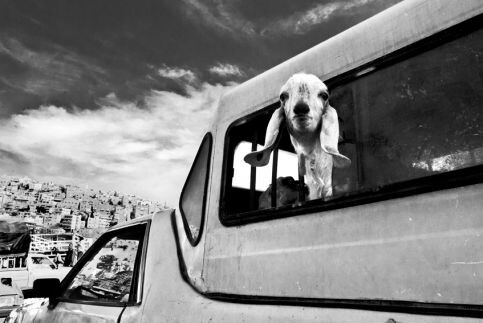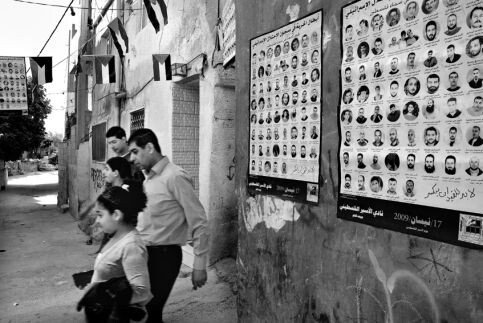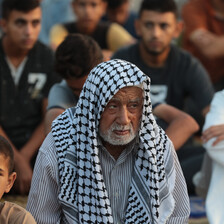The Electronic Intifada Aida refugee camp 25 November 2010

The holiday of Eid al-Ahda — the Feast of the Sacrifice — is celebrated by Muslims across the world to commemorate the prophet Abraham’s sacrifice of a sheep in the place of his son Ishmael. Palestine is no different than most countries where the holiday is observed, but with one notable exception: the Israeli occupation. While sheep are smuggled into Gaza from Egypt through underground tunnels, Palestinians in the West Bank face their own Israeli-imposed restrictions. These hardships however fail to dim the generosity, grace and sense of community that mark these three holy days of Eid.
Israeli military checkpoints limit the access of family visits to the homes of relatives and deny the exit of hundreds of Palestinians wanting to leave the West Bank to make the Hajj pilgrimage to Mecca. The Stop the Wall Campaign reported that 46 percent of the West Bank will be annexed to Israel once the separation wall is completed, denying farmers and villagers access to their land. More than one-third of the West Bank land is “closed” for Israeli military training and a further 31 percent is controlled by Israeli settlements, according to the UNHCR. The result is that Palestinian farmers including sheep herders are left in severe economic difficulty at a time when business should be thriving.
Despite the Israeli control over the area, the spirit and kindness of the festivities prevails even among those worst affected by the occupation. Curious to experience the true meaning of this special holiday, I visited with families and friends in Aida refugee camp in the Bethlehem district. Situated in Area C of the West Bank — where the Israeli occupation maintains total control — and almost entirely surrounded by Israel’s wall including four military watchtowers that were completed in the area in 2007, the camp’s inhabitants are constantly reminded of the reality of occupation. Yet during the holiday the camp’s narrow streets were filled with people greeting and congratulating everyone who passed by. Boys played with their new toy guns and girls walked hand-in-hand parading proudly in their colorful outfits. One family told me their dream of owning land in order to keep their own sheep. Another insisted on the importance of remembering Palestinian prisoners, often held in Israeli jails with no official charges and little opportunity to receive visits from their loved ones.
At times the festivities were burdened by a somber tone — a constant reminder of the Palestinian struggle for freedom and independence — but somehow I left feeling reconnected with a more than subtle sense of hope and happiness.
All images were taken by Sanne Winderickx during the Eid al-Adha holiday in Bethlehem and the Aida refugee camp.

A Palestinian villager comes to Bethlehem with his sheep, hoping to find a buyer.

Three days before the first holy day of Eid al-Adha, sheep owners gather in a valley behind Bethlehem’s city center to show off their livestock to Muslims who no longer keep their own. Whether you have twenty sheep to sell or only one, this is the place to negotiate the best price for the holiday celebration.

Proud new owners of their sheep load the sacrificial animal onto their vehicle.

Men and boys assess the quality of the sheep.

After the morning call to prayer on the first day of Eid al-Adha, families visit the graves of families and loved ones. While the holiday is meant to be a day of celebration and happiness, for many it is also a day of remembrance.

In Aida Refugee Camp, political prisoners in Israeli jails are remembered by hanging their pictures along the buildings of the camp.

The large size of some families often means that the trunk of the car is reserved for children. But the thought of receiving money and sweets from their relatives makes the trip an exciting adventure not to be missed.

A family event, the act of sacrificing the sheep is done in the home. It is said that only those who witness the slaughter may eat from its meat.

After weighing the meat it is divided equally into three parts. One-third for the family, one-third for friends and neighbors and, as is the tradition, the last third is distributed to the poor who are seldom able to eat meat. Eleven bags of meat have been prepared and labelled which the children will humbly bring to the homes of the families they wish to support.

Throughout the day men walk through the streets of the camp greeting their friends. Children in the streets are entertained by visiting one of the many street stands, bringing a vibrant spirit of unity to the camp to celebrate the holiday.

The second day of the Eid al-Adha holiday brings the family together for a feast of mansaf, a traditional Palestinian meal of lamb, rice and pine nuts.
Sanne Winderickx is a Belgian freelance photographer currently working in Bethlehem, Palestine where she also teaches documentary filmmaking at the Lajee Center in Aida refugee camp.


